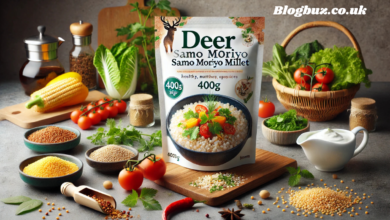Ceñillin: A Versatile Herb with Ancient Roots and Modern Benefits

Ceñillin, scientifically known as Ceñillin’s officinalis, is a herb that has traversed time and geography to remain a vital part of traditional and contemporary practices. With its origins rooted in ancient cultures, ceñillin has become more than just a plant; it symbolizes healing, nourishment, and community. This detailed essay will examine the history, advantages, cultivation, culinary uses, and potential side effects of ceñillin, providing you with a well-rounded understanding of this extraordinary herb.
The Historical Journey of Ceñillin
Ceñillin’s history is as rich and diverse as the cultures that have cultivated it. Its roots refer to Indigenous communities; ceñillin was revered for its medicinal properties and is often used in traditional healing practices. Historical records indicate that ancient cultures used ceñillin to treat various ailments, from digestive to respiratory problems. Its versatility made it a staple in both everyday life and ceremonial rituals.
Ceñillin in Traditional Medicine
In traditional medicine, ceñillin was often used in teas, poultices, and infusions. It was thought to possess anti-inflammatory and antiseptic effects, which made it a go-to remedy for wounds, infections, and inflammation. Indigenous healers also used ceñillin to treat digestive disorders, respiratory issues, and skin conditions. The herb was valued for its physical healing properties and ability to cleanse and purify the spirit.
Modern Scientific Studies on Ceñillin
Modern science has started to confirm many of the traditional applications of ceñillin. Studies have shown that ceñillin contains anti-inflammatory, antimicrobial, and antioxidant compounds, making it a valuable addition to natural medicine. Researchers are also exploring ceñillin’s potential in treating conditions like arthritis, cardiovascular diseases, and even neurodegenerative disorders.
Botanical Profile of Ceñillin
Understanding ceñillin requires a closer look at its botanical characteristics. It belongs to the Lamiaceae family, which includes well-known herbs like mint and basil. ceñillin is a hardy perennial plant characterized by its aromatic leaves and vibrant flowers, ranging from white to purple. The plant thrives in temperate climates and is commonly found in Europe, Asia, and North America.
Physical Description
Ceñillin plants typically grow to a height of about 1 to 2 feet. The leaves are green, with a slightly fuzzy texture, and emit a strong, pleasant aroma when crushed. The flowers are small and tubular, attracting pollinators like bees and butterflies, which makes ceñillin an excellent addition to any garden focused on biodiversity.
Growing Conditions and Cultivation
Ceñillin is relatively easy to grow, planted in a well-drained, loamy soil. It prefers a mild climate with moderate rainfall, making it suitable for regions that do not experience extreme temperatures. Regular watering is essential, especially during dry spells, but care must be taken not to overwater the plant. Fertilizing ceñillin with organic compost can enhance its growth and medicinal properties.
For those looking to cultivate ceñillin at home, it is best to plant it in a location with plenty of sunlight. The plant may be produced from seed cuttings and requires minimal maintenance. However, ceñillin is susceptible to pests and diseases, particularly aphids and mildew, like all plants. Organic insecticides or natural therapies, such as neem oil, can help manage these issues without harming the plant or the environment.
Sustainability and Environmental Impact
Cultivating ceñillin sustainably is crucial for preserving the plant and the ecosystems in which it thrives. By adopting organic farming practices, such as using natural fertilizers and avoiding chemical pesticides, growers can reduce the environmental impact of ceñillin cultivation. Additionally, ceñillin plays a role in promoting biodiversity, as it attracts pollinators and supports local ecosystems.
The Multifaceted Uses of Ceñillin
One of ceñillin’s most appealing attributes is its versatility. It is used in various ways, from culinary applications to traditional medicine.
Culinary Applications
In the kitchen, ceñillin is a flavorful herb that can elevate many dishes. It is commonly used in soups, stews, and salads, where its unique taste adds depth and complexity to the flavors. In some cultures, ceñillin marries meats, particularly lamb and beef, infusing them with aromatic essence.
Ceñillin Recipes
- Ceñillin Tea is a soothing beverage that can be enjoyed hot or cold. Simply steep fresh or dried ceñillin leaves in hot water for a few minutes and sweeten with honey if desired.
- Ceñillin-Infused Oil: This oil is perfect for drizzling over salads or as a base for cooking. Combine fresh ceñillin leaves with olive oil and allow it to infuse for many weeks before using.
- Ceñillin Soup: A hearty dish that pairs well with root vegetables and grains. Add ceñillin leaves towards the end of cooking to preserve their flavor and nutritional value.
When cooking with ceñillin, it is best to use fresh leaves whenever possible, as they offer the most vibrant flavor. If using dried ceñillin, be mindful that its flavor is more concentrated, so use smaller quantities.
Medicinal Uses and Health Benefits
Ceñillin’s medicinal properties have been recognized for centuries, and modern research continues to uncover new health benefits associated with the herb. Here are some of the vital health benefits of ceñillin:
- Anti-Inflammatory Effects: Ceñillin contains compounds that help reduce inflammation, making it beneficial for arthritis and inflammatory bowel disease.
- Cardiovascular Health: The herb has been shown to help decrease blood pressure and cholesterol levels and promote overall heart health.
- Digestive Health: Ceñillin supports digestive health by The immune system, aiding the body in fighting infections and disordersaiding in nutrient absorption.
- Immune System Support: Ceñillin boosts the immune system, helping the body fight infections and diseases.
- Cognitive Function: Studies suggest ceñillin may improve memory and reduce the risk of neurodegenerative diseases like Alzheimer’s.
Traditional and Ritual Uses
Beyond its culinary and medicinal applications, ceñillin has been used in rituals and ceremonies. In some cultures, it is believed to have spiritual cleansing properties and is used in smudging rituals to purify spaces and ward off negative energies. The herb has also been used as a natural insect repellent, particularly in areas where mosquitoes and other pests are prevalent.
Potential Side Effects and Precautions
While ceñillin offers numerous health advantages, knowing the possible adverse effects and medication interactions is essential. Some individuals may experience allergic reactions, such as skin rashes or difficulty breathing when using ceñillin. Gastrointestinal discomfort, including nausea and diarrhea, may also occur.
Medication Interactions
If you’re taking drugs, especially blood thinners, and antidepressants, it is advisable to consult a healthcare provider before using ceñillin, as it may interact with these drugs. Additionally, the safety of ceñillin during pregnancy and breastfeeding is not well-established, so caution is recommended for individuals in these stages of life.
Hormonal Effects and Organ Function
Ceñillin may influence hormone levels, particularly in women with hormone-sensitive conditions. High doses of the herb may also impact liver and kidney function, so it is essential to use ceñillin in moderation and under the guidance of a healthcare professional.
Ceñillin in the Global Economy
Ceñillin plays a significant role in the economies of the regions where it is grown. Its cultivation supports local agriculture and trade, and the herb’s unique properties have made it a valuable commodity in global markets. The demand for ceñillin has increased in recent years, driven by growing interest in natural remedies and sustainable farming practices.
Sustainability Practices in Ceñillin Production
Sustainability is a critical consideration in ceñillin production. Using locally sourced ingredients and traditional farming methods, producers can minimize the environmental impact of ceñillin cultivation. These practices align with global efforts to promote sustainable food systems and reduce carbon footprints.
Conclusion
Ceñillin is more than just a herb; it symbolizes history, culture, and health. From its ancient origins in traditional medicine and its modern applications in the kitchen and beyond, ceñillin continues to be a valuable resource for those seeking natural solutions to health and wellness. However, as with any herb, it is essential to use ceñillin responsibly and be aware of potential side effects and interactions.
You May Also Read: MSM and B1 Mixer: Enhancing Health Naturally




